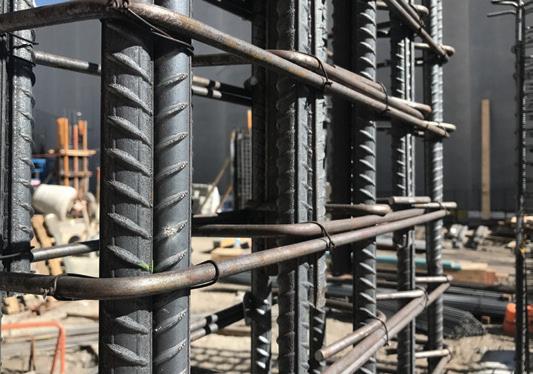
5 minute read
A LONG-TERM STRATEGY FOR SUPPLY CHAIN INFRASTRUCTURE
A LONG-TERM STRATEGY
FOR SUPPLY CHAIN INFRASTRUCTURE
Advertisement
by Port of Melbourne
In early 2020, Port of Melbourne received government approval for the major $125 million Port Rail Transformation Project to go ahead. The significant rail works form part of a larger future infrastructure strategy for the port involving plans to increase container handling capacity, port side road infrastructure, and a new liquid bulk berth.
Just as Australia's ports have played a critical role in keeping Australia moving during the COVID-19 crisis, it's clear they will be the gateway to the nation's economic fortunes post-pandemic as we look to breathe new life into sectors, big and small. As our economy rebuilds and we begin thinking long term again, ports will play a pivotal role in Australia's economic future.
For Port of Melbourne, our task is threefold: optimise the efficiency and effectiveness of our port operations, facilitate Australia's vital link in the global supply chain, and continue to invest in infrastructure to meet our growth forecasts.
RAIL PROJECT GIVEN GREEN LIGHT
Earlier this year, the State Government gave the all-clear for our Port Rail Transformation Project (PRTP). It's an initiative many years in the making that will ease congestion for local communities, ensure an efficient supply chain for freight and business, and support Australia's economy through a productive Port of Melbourne.
Funded by a tariff on full import containers, the $125 million rail project will involve significant rail infrastructure works and a new rail operating framework inside the port.
The project involves: ♦ Development of a new on-dock rail terminal at Swanson
Dock East to ensure a lower cost transfer of containers between rail and ships ♦ Restructuring the port rail land and asset commercial arrangements for port Rail Terminal Operators to provide rail land and assets on a similar basis it provides wharf and road assets and land ♦ New working arrangements between Port of Melbourne
Operations and port Rail Terminal Operators at most current and all future port rail terminals
The investment in PRTP is essential to maximising the port's capacity and improving landside transport connections for industry; and it's set to pay significant social, environmental and economic dividends. It will make our roads safer, reduce pollution, cut costs for exporters and, ultimately, allow Melbourne to maintain its competitive position within the national port freight system.
Our Port Rail Transformation is also a central part of our broader infrastructure investment plan which recognises the need for the port's land, and the infrastructure on it, to be used efficiently and productively over the next 30 years.
As our population grows and interstate and international trade increases, the demand for access to Melbourne's port will continue to grow. Our analysis shows that over the next 30 years, total container trade volumes will grow from three million TEU each year, to around 8.9 million TEU by 2050.
TO SUPPORT THIS GROWTH, WE NEED TO GET BUILDING
Infrastructure planning, approvals and delivery timeframes mean the next phase of port expansion needs to commence now, and we are committed to working with industry, government and all stakeholders to make it happen.
There are several projects in addition to our immediate investments in rail that will need to be delivered in the coming decade to support the forecast growth in trade and ensure our infrastructure can cater to growing demands.
First and foremost, we need to invest in terminal capacity

FOR SUPPLY CHAIN INFRASTRUCTURE
to support increased container freight. This means investing in container handling capacity at Webb Dock. As the precinct will cater for the significant growth in trade demand, Webb Dock must be directly connected to the state and national rail network via the Webb Dock Freight Link.
Investing in growth also means investing in port side road infrastructure. Currently, the port has adequate connections to Victoria's arterial road network. However, as the trade demand grows, our population and city is also set to grow, which will present a range of road network issues for port users and the local community.
In addition to our efforts to ensure more freight is carried by rail and our work with industry to get the best out of our network infrastructure, we are also committed to working with the relevant road agencies to explore road projects that will reduce traffic in Melbourne's inner west, maximise utilisation of the existing network, and ensure efficiencies in the road network connections around Swanson Dock and Webb Dock.
Infrastructure that will support demand on the bulk liquid pipeline network is another investment priority. While Port of Melbourne is currently well-serviced by the existing bulk liquid pipeline networks, in order to support anticipated liquid bulk growth, we're investigating options for the development of a new liquid bulk berth.
With a number of options under investigation, a new liquid bulk berth would be connected by new pipelines to the existing refined petroleum product storage and distribution facilities in Yarraville, Spotswood, Newport and Altona.
Lastly, a range of specific and targeted improvements to port land are critical to our long-term supply chain infrastructure planning. When the West Gate Tunnel opens, port land south of Somerville Road will be returned for port use. Port of Melbourne intends to put this land to market to identify the most optimal use, which could include liquid bulk storage and distribution, freight logistics and storage, or empty container storage.
LOOKING TO THE FUTURE
A strategic site for the port is the former Melbourne Wholesale Market Site in Dynon. The development of the former Melbourne Market site is critical to reducing the impact of congestion on supply chain costs and communities, and we’re exploring options for this precinct.
Whether it’s land development, rail transformation, terminal upgrades or road network management, our infrastructure investment plan is focused on ensuring Port of Melbourne can plan and develop port capacity and supply chain efficiencies that enhance the competitive position of Victoria and liveability of greater Melbourne.
Port of Melbourne Operations is a steward of the Port of Melbourne and works in partnership with our customers, industry, the community and government to ensure the right investment, at the right time to deliver the right outcomes for everyone’s benefit. Our 30 year Port Development Strategy sets the framework for this investment and ensures that we can work collaboratively with all stakeholders to achieve this outcome.
Optimising existing facilities and built infrastructure, combined with targeted delivery of new infrastructure, will enable the port to cater for Victoria’s growth and deliver for all Victorians well into the future.










